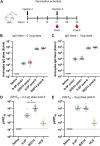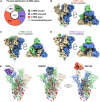Structural and computational design of a SARS-CoV-2 spike antigen with improved expression and immunogenicity
- PMID: 37285422
- PMCID: PMC10246912
- DOI: 10.1126/sciadv.adg0330
Structural and computational design of a SARS-CoV-2 spike antigen with improved expression and immunogenicity
Abstract
Severe acute respiratory syndrome coronavirus 2 (SARS-CoV-2) variants of concern challenge the efficacy of approved vaccines, emphasizing the need for updated spike antigens. Here, we use an evolutionary-based design aimed at boosting protein expression levels of S-2P and improving immunogenic outcomes in mice. Thirty-six prototype antigens were generated in silico and 15 were produced for biochemical analysis. S2D14, which contains 20 computationally designed mutations within the S2 domain and a rationally engineered D614G mutation in the SD2 domain, has an ~11-fold increase in protein yield and retains RBD antigenicity. Cryo-electron microscopy structures reveal a mixture of populations in various RBD conformational states. Vaccination of mice with adjuvanted S2D14 elicited higher cross-neutralizing antibody titers than adjuvanted S-2P against the SARS-CoV-2 Wuhan strain and four variants of concern. S2D14 may be a useful scaffold or tool for the design of future coronavirus vaccines, and the approaches used for the design of S2D14 may be broadly applicable to streamline vaccine discovery.
Figures








Similar articles
-
SARS-CoV-2 spike produced in insect cells elicits high neutralization titres in non-human primates.Emerg Microbes Infect. 2020 Dec;9(1):2076-2090. doi: 10.1080/22221751.2020.1821583. Emerg Microbes Infect. 2020. PMID: 32897177 Free PMC article.
-
Elicitation of Broadly Neutralizing Antibodies against B.1.1.7, B.1.351, and B.1.617.1 SARS-CoV-2 Variants by Three Prototype Strain-Derived Recombinant Protein Vaccines.Viruses. 2021 Jul 22;13(8):1421. doi: 10.3390/v13081421. Viruses. 2021. PMID: 34452287 Free PMC article.
-
A mosaic-type trimeric RBD-based COVID-19 vaccine candidate induces potent neutralization against Omicron and other SARS-CoV-2 variants.Elife. 2022 Aug 25;11:e78633. doi: 10.7554/eLife.78633. Elife. 2022. PMID: 36004719 Free PMC article.
-
The E484K Substitution in a SARS-CoV-2 Spike Protein Subunit Vaccine Resulted in Limited Cross-Reactive Neutralizing Antibody Responses in Mice.Viruses. 2022 Apr 21;14(5):854. doi: 10.3390/v14050854. Viruses. 2022. PMID: 35632595 Free PMC article.
-
The Influence of Adjuvant Type on the Immunogenicity of RBD/N Cocktail Antigens as a Vaccine Candidate against SARS-CoV-2 Virus.Microbiol Spectr. 2023 Jun 15;11(3):e0256422. doi: 10.1128/spectrum.02564-22. Epub 2023 May 18. Microbiol Spectr. 2023. PMID: 37199661 Free PMC article.
Cited by
-
Stabilized designs of the malaria adhesin protein PvRBP2b for use as a potential diagnostic for Plasmodium vivax.J Biol Chem. 2025 Mar;301(3):108290. doi: 10.1016/j.jbc.2025.108290. Epub 2025 Feb 10. J Biol Chem. 2025. PMID: 39938801 Free PMC article.
-
Just Keep Rolling?-An Encompassing Review towards Accelerated Vaccine Product Life Cycles.Vaccines (Basel). 2023 Jul 27;11(8):1287. doi: 10.3390/vaccines11081287. Vaccines (Basel). 2023. PMID: 37631855 Free PMC article. Review.
-
Computational Protein Design for COVID-19 Research and Emerging Therapeutics.ACS Cent Sci. 2023 Mar 20;9(4):602-613. doi: 10.1021/acscentsci.2c01513. eCollection 2023 Apr 26. ACS Cent Sci. 2023. PMID: 37122454 Free PMC article. Review.
-
Changes in the motifs in the D0 and SD2 domains of the S protein drive the evolution of virulence in enteric coronavirus porcine epidemic diarrhea virus.J Virol. 2025 Apr 15;99(4):e0209224. doi: 10.1128/jvi.02092-24. Epub 2025 Mar 4. J Virol. 2025. PMID: 40035514 Free PMC article.
-
Strategies of rational and structure-driven vaccine design for Arenaviruses.Infect Genet Evol. 2024 Sep;123:105626. doi: 10.1016/j.meegid.2024.105626. Epub 2024 Jun 20. Infect Genet Evol. 2024. PMID: 38908736 Free PMC article. Review.
References
-
- E. Volz, S. Mishra, M. Chand, J. C. Barrett, R. Johnson, L. Geidelberg, W. R. Hinsley, D. J. Laydon, G. Dabrera, Á. O’Toole, R. Amato, M. Ragonnet-Cronin, I. Harrison, B. Jackson, C. V. Ariani, O. Boyd, N. J. Loman, J. T. McCrone, S. Gonçalves, D. Jorgensen, R. Myers, V. Hill, D. K. Jackson, K. Gaythorpe, N. Groves, J. Sillitoe, D. P. Kwiatkowski; COVID-19 Genomics UK (COG-UK) consortium, S. Flaxman, O. Ratmann, S. Bhatt, S. Hopkins, A. Gandy, A. Rambaut, N. M. Ferguson, Assessing transmissibility of SARS-CoV-2 lineage B.1.1.7 in England. Nature 593, 266–269 (2021). - PubMed
-
- H. Tegally, E. Wilkinson, M. Giovanetti, A. Iranzadeh, V. Fonseca, J. Giandhari, D. Doolabh, S. Pillay, E. J. San, N. Msomi, K. Mlisana, A. von Gottberg, S. Walaza, M. Allam, A. Ismail, T. Mohale, A. J. Glass, S. Engelbrecht, G. van Zyl, W. Preiser, F. Petruccione, A. Sigal, D. Hardie, G. Marais, N. Y. Hsiao, S. Korsman, M. A. Davies, L. Tyers, I. Mudau, D. York, C. Maslo, D. Goedhals, S. Abrahams, O. Laguda-Akingba, A. Alisoltani-Dehkordi, A. Godzik, C. K. Wibmer, B. T. Sewell, J. Lourenço, L. C. J. Alcantara, S. L. Kosakovsky Pond, S. Weaver, D. Martin, R. J. Lessells, J. N. Bhiman, C. Williamson, T. de Oliveira, Detection of a SARS-CoV-2 variant of concern in South Africa. Nature 592, 438–443 (2021). - PubMed
-
- S. Jangra, C. Ye, R. Rathnasinghe, D. Stadlbauer, F. Krammer, V. Simon, L. Martinez-Sobrido, A. García-Sastre, M. Schotsaert, H. Alshammary, A. A. Amoako, M. H. Awawda, K. F. Beach, M. C. Bermúdez-González, R. L. Chernet, L. Q. Eaker, E. D. Ferreri, D. L. Floda, C. R. Gleason, G. Kleiner, D. Jurczyszak, J. C. Matthews, W. A. Mendez, L. C. F. Mulder, K. T. Russo, A. B. T. Salimbangon, M. Saksena, A. S. Shin, L. A. Sominsky, K. Srivastava, SARS-CoV-2 spike E484K mutation reduces antibody neutralisation. Lancet Microbe 2, e283–e284 (2021). - PMC - PubMed
MeSH terms
Substances
LinkOut - more resources
Full Text Sources
Medical
Miscellaneous

